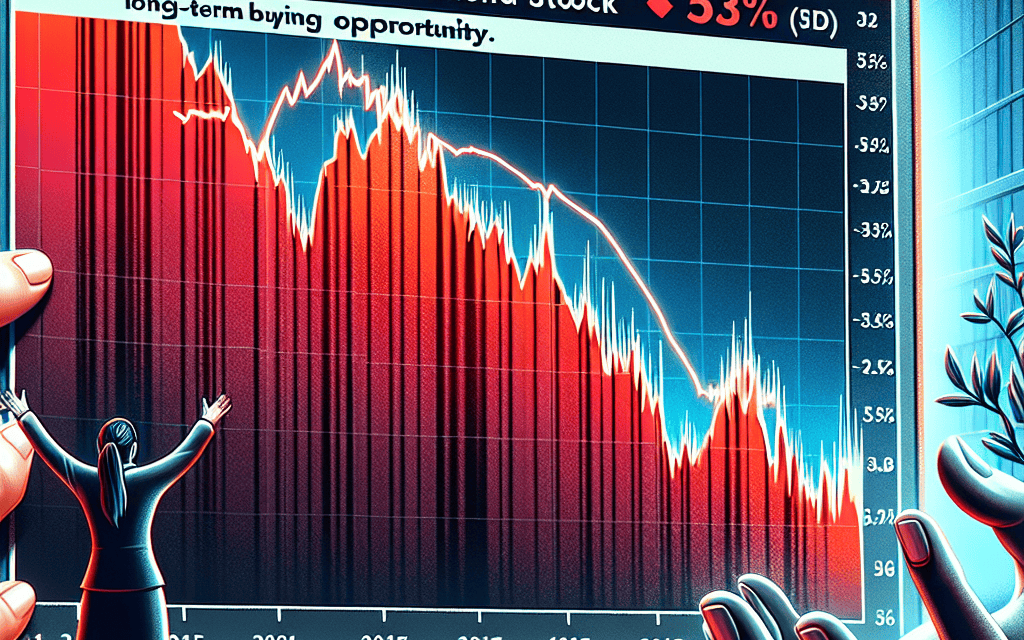“Seize the Dip: Invest in Timeless Value with S&P 500’s Hidden Gem”
Introduction
The S&P 500 is home to some of the most robust and reliable dividend-paying stocks, often serving as a cornerstone for long-term investment portfolios. Among these, a particular stock has recently caught the attention of savvy investors due to its significant price decline of 53%, presenting a potentially lucrative buy-and-hold opportunity. Despite the downturn, this stock remains exceptional, backed by strong fundamentals and a history of consistent dividend payouts. Its current undervaluation could offer investors a rare chance to acquire a high-quality asset at a discounted price, promising both income and growth potential over the long haul. As market conditions fluctuate, this stock stands out as a compelling option for those seeking to capitalize on its resilience and the enduring strength of its underlying business model.
Understanding The S&P 500: A Guide To Dividend Stocks
The S&P 500, a benchmark index that represents 500 of the largest publicly traded companies in the United States, is often regarded as a barometer for the overall health of the U.S. stock market. Within this index, dividend stocks hold a special place for investors seeking both income and growth. Dividend stocks are shares in companies that return a portion of their earnings to shareholders in the form of dividends. These stocks are particularly attractive to long-term investors who value the combination of regular income and potential capital appreciation. However, not all dividend stocks are created equal, and understanding their nuances is crucial for making informed investment decisions.
One such dividend stock within the S&P 500 has recently caught the attention of investors due to its significant price decline of 53%. While a drop of this magnitude might initially raise concerns, it can also present a unique buying opportunity for those with a long-term investment horizon. The key to evaluating whether this stock is a buy-and-hold opportunity lies in understanding the underlying factors contributing to its price decline and assessing its future potential.
Firstly, it is essential to consider the reasons behind the stock’s recent underperformance. Market volatility, sector-specific challenges, or company-specific issues can all contribute to a stock’s decline. By analyzing these factors, investors can determine whether the price drop is a temporary setback or indicative of more serious, long-term problems. For instance, if the decline is primarily due to short-term market fluctuations or cyclical downturns, the stock may still hold significant potential for recovery and growth.
Moreover, the company’s fundamentals play a critical role in assessing its viability as a long-term investment. A strong balance sheet, consistent cash flow, and a history of stable or growing dividends are indicators of a company’s financial health and its ability to weather economic downturns. Additionally, a company with a competitive advantage, such as a strong brand, proprietary technology, or a dominant market position, is more likely to sustain its dividend payments and deliver long-term value to shareholders.
Furthermore, the stock’s dividend yield is an important consideration for income-focused investors. A high dividend yield can be attractive, but it is crucial to ensure that the yield is sustainable. A yield that is significantly higher than the industry average may indicate potential risks, such as an impending dividend cut. Therefore, investors should evaluate the company’s payout ratio, which measures the proportion of earnings paid out as dividends, to ensure that the dividend is supported by the company’s earnings.
In addition to these factors, investors should also consider the broader economic environment and its impact on the company’s prospects. Economic indicators such as interest rates, inflation, and GDP growth can influence the performance of dividend stocks. For example, in a low-interest-rate environment, dividend stocks may become more attractive to investors seeking higher yields than those offered by fixed-income securities.
In conclusion, while a 53% decline in an S&P 500 dividend stock may initially appear alarming, it can also present a compelling buy-and-hold opportunity for discerning investors. By carefully analyzing the reasons behind the stock’s decline, evaluating the company’s fundamentals, and considering the broader economic context, investors can make informed decisions that align with their long-term investment goals. Ultimately, a well-chosen dividend stock can provide both income and growth, making it a valuable addition to a diversified investment portfolio.
Analyzing The 53% Drop: What It Means For Investors
The recent 53% decline in the value of an exceptional S&P 500 dividend stock has caught the attention of many investors, prompting a closer examination of what this drop signifies for potential long-term investment opportunities. While such a significant decrease in stock price might initially appear alarming, it is essential to delve deeper into the underlying factors contributing to this decline and assess whether it presents a viable buy-and-hold opportunity for discerning investors.
To begin with, the broader market conditions have played a substantial role in the stock’s downturn. Economic uncertainties, fluctuating interest rates, and geopolitical tensions have collectively exerted pressure on the stock market, leading to volatility across various sectors. In this context, even fundamentally strong companies have not been immune to market-wide sell-offs. Consequently, the 53% drop in this particular dividend stock may not necessarily reflect a deterioration in the company’s intrinsic value but rather a reaction to external market forces.
Moreover, it is crucial to consider the company’s financial health and operational performance. Despite the decline in stock price, the company continues to demonstrate robust financial metrics, including a strong balance sheet, consistent revenue streams, and a history of stable dividend payouts. These factors underscore the company’s resilience and its ability to weather economic downturns. Furthermore, the company’s commitment to returning value to shareholders through dividends remains unwavering, making it an attractive option for income-focused investors.
In addition to financial stability, the company’s strategic initiatives and growth prospects warrant attention. The management team has been proactive in adapting to changing market dynamics, investing in innovation, and expanding into new markets. These efforts are likely to enhance the company’s competitive position and drive long-term growth. As a result, the current dip in stock price may offer a compelling entry point for investors who believe in the company’s long-term vision and growth potential.
Transitioning to the valuation aspect, the stock’s current price level presents an opportunity to acquire shares at a significant discount. Historically, market corrections have often provided astute investors with the chance to purchase high-quality stocks at attractive valuations. By taking a long-term perspective, investors can capitalize on the potential for capital appreciation as the market eventually recovers and the stock price realigns with the company’s intrinsic value.
Furthermore, the stock’s dividend yield has become increasingly appealing due to the price drop. A higher yield not only enhances the income-generating potential of the investment but also provides a cushion against market volatility. For investors seeking a reliable income stream, this dividend stock offers a compelling proposition, especially when considering the company’s track record of maintaining and growing its dividend payouts over time.
In conclusion, while the 53% decline in this exceptional S&P 500 dividend stock may initially raise concerns, a comprehensive analysis reveals that it could represent a unique buy-and-hold opportunity. By examining the broader market context, the company’s financial health, strategic initiatives, and attractive valuation, investors can make informed decisions about the stock’s potential for long-term growth and income generation. As with any investment, it is crucial to conduct thorough due diligence and consider individual risk tolerance before making a commitment. However, for those with a long-term investment horizon, this stock may indeed offer a promising addition to a diversified portfolio.
The Power Of Dividend Stocks In A Volatile Market
In the ever-fluctuating landscape of financial markets, dividend stocks have long been regarded as a beacon of stability and a reliable source of income for investors. The S&P 500, a benchmark index that tracks the performance of 500 of the largest companies listed on stock exchanges in the United States, includes numerous dividend-paying stocks that have historically provided a cushion against market volatility. Among these, there exists an exceptional dividend stock that has recently experienced a significant decline, dropping 53% from its previous highs. This presents a unique buy-and-hold opportunity for investors seeking long-term growth and income.
Dividend stocks are particularly appealing in volatile markets due to their ability to generate consistent income regardless of market conditions. Companies that pay dividends are often well-established, with strong cash flows and a commitment to returning value to shareholders. This financial stability can provide a sense of security for investors, especially during periods of economic uncertainty. Moreover, dividends can be reinvested to purchase additional shares, compounding returns over time and enhancing the overall growth potential of an investment portfolio.
The recent decline of this particular S&P 500 dividend stock may initially raise concerns among investors. However, it is essential to consider the underlying factors contributing to this drop. Market fluctuations can be driven by a myriad of reasons, including macroeconomic trends, industry-specific challenges, or even short-term investor sentiment. It is crucial to differentiate between temporary setbacks and fundamental weaknesses in a company’s business model. In this case, the stock’s decline may be attributed to external factors rather than intrinsic issues, suggesting that the company’s long-term prospects remain intact.
Investors should also consider the historical performance and resilience of the company in question. Many dividend-paying companies have weathered economic downturns and emerged stronger, thanks to their robust business models and prudent management strategies. By focusing on the company’s fundamentals, such as its revenue growth, profit margins, and debt levels, investors can gain a clearer understanding of its potential to recover and continue delivering value over the long term.
Furthermore, the current market environment presents an opportune moment for investors to capitalize on the stock’s reduced price. Buying shares at a lower valuation not only increases the potential for capital appreciation but also enhances the dividend yield, providing a higher return on investment. This is particularly advantageous for income-focused investors who prioritize steady cash flow from their investments.
In conclusion, while the 53% decline of this exceptional S&P 500 dividend stock may initially appear daunting, it represents a compelling buy-and-hold opportunity for discerning investors. By focusing on the power of dividend stocks in a volatile market, investors can benefit from the stability and income they provide, while also positioning themselves for long-term growth. As always, it is essential to conduct thorough research and consider one’s individual financial goals and risk tolerance before making investment decisions. However, for those willing to look beyond short-term market fluctuations, this dividend stock offers the potential for enduring value and a reliable source of income for years to come.
Long-Term Investment Strategies: Buy-And-Hold Explained

In the realm of long-term investment strategies, the buy-and-hold approach has consistently proven to be a reliable method for building wealth over time. This strategy involves purchasing stocks and holding onto them for an extended period, regardless of market fluctuations. One of the most compelling aspects of this approach is its ability to capitalize on the power of compounding, particularly when it comes to dividend stocks. A prime example of an exceptional S&P 500 dividend stock that has recently caught the attention of investors is one that has experienced a significant decline of 53%. Despite this downturn, it presents a remarkable buy-and-hold opportunity for those with a long-term perspective.
To understand why this stock is a potential gem for investors, it is essential to consider the fundamentals that underpin its value. Companies that are part of the S&P 500 index are typically well-established, with a track record of stability and growth. When such a company experiences a substantial drop in its stock price, it often signals a temporary setback rather than a permanent decline in its intrinsic value. This presents a unique opportunity for investors to acquire shares at a discounted price, thereby enhancing potential returns when the stock eventually rebounds.
Moreover, dividend stocks offer an additional layer of appeal for buy-and-hold investors. These stocks provide regular income through dividend payments, which can be reinvested to purchase more shares, further compounding returns over time. The company in question, despite its recent price decline, continues to maintain a robust dividend payout, underscoring its commitment to returning value to shareholders. This consistent dividend payment not only provides a steady income stream but also serves as an indicator of the company’s financial health and resilience.
Furthermore, the current market environment presents a favorable backdrop for long-term investors. Economic cycles are characterized by periods of expansion and contraction, and while short-term volatility can be unsettling, it often creates opportunities for those willing to look beyond immediate market conditions. By focusing on the underlying strengths of a company, such as its competitive advantages, management quality, and growth prospects, investors can make informed decisions that align with their long-term financial goals.
In addition, the psychological aspect of investing cannot be overlooked. The buy-and-hold strategy requires discipline and patience, as it involves resisting the urge to react to short-term market movements. This approach is particularly relevant in the context of the current stock, as its recent price decline may deter some investors. However, those who remain steadfast in their commitment to the strategy are likely to be rewarded in the long run, as the stock’s fundamentals suggest a strong potential for recovery and growth.
In conclusion, the exceptional S&P 500 dividend stock that has experienced a 53% decline represents a compelling buy-and-hold opportunity for long-term investors. By focusing on the company’s intrinsic value, dividend stability, and growth prospects, investors can position themselves to benefit from future appreciation and income generation. As with any investment, it is crucial to conduct thorough research and consider one’s risk tolerance before making a decision. However, for those who embrace the buy-and-hold philosophy, this stock offers the potential for substantial returns over time, making it a worthy addition to a diversified investment portfolio.
Evaluating Risk Vs. Reward In Dividend Stock Investments
Investing in dividend stocks has long been a favored strategy for those seeking a balance between income generation and capital appreciation. The allure of dividend stocks lies in their ability to provide a steady stream of income, even during periods of market volatility. However, the recent downturn of an exceptional S&P 500 dividend stock, now down 53%, presents a unique opportunity for investors willing to evaluate the risk versus reward dynamics inherent in such investments. This scenario underscores the importance of a thorough analysis before committing to a buy-and-hold strategy.
To begin with, the decline in the stock’s value may initially appear alarming, yet it is crucial to delve deeper into the underlying factors contributing to this drop. Market fluctuations, economic downturns, or company-specific challenges can all play a role in driving down stock prices. However, these factors do not necessarily reflect the long-term potential of the company. In fact, a significant price drop can sometimes present a buying opportunity for astute investors who recognize the stock’s intrinsic value and future growth prospects.
Moreover, the company’s ability to maintain or even increase its dividend payouts during challenging times is a testament to its financial health and management’s commitment to returning value to shareholders. A consistent dividend history, coupled with a sustainable payout ratio, can provide reassurance that the company is well-positioned to weather economic storms. This stability is particularly appealing to long-term investors who prioritize income generation as part of their investment strategy.
Furthermore, the concept of risk versus reward is central to any investment decision. While the stock’s current price may reflect heightened risk, it is essential to weigh this against the potential rewards. A thorough analysis of the company’s fundamentals, including its revenue streams, competitive positioning, and growth prospects, can offer insights into its ability to rebound and deliver long-term value. Additionally, understanding the broader industry trends and economic conditions can help investors gauge the likelihood of a recovery.
In addition to evaluating the company’s fundamentals, investors should also consider their own risk tolerance and investment horizon. A buy-and-hold strategy requires patience and a willingness to endure short-term volatility in pursuit of long-term gains. For those with a higher risk tolerance and a long-term perspective, the current price drop may represent an attractive entry point. Conversely, more risk-averse investors may prefer to wait for further stabilization before committing capital.
Transitioning from analysis to action, it is imperative for investors to remain vigilant and informed. Regularly monitoring the company’s performance, industry developments, and macroeconomic indicators can help investors make informed decisions and adjust their strategies as needed. This proactive approach ensures that investors are well-equipped to navigate the complexities of the market and capitalize on opportunities as they arise.
In conclusion, the 53% decline of an exceptional S&P 500 dividend stock presents a compelling case for evaluating the risk versus reward dynamics of dividend stock investments. By conducting a thorough analysis of the company’s fundamentals, understanding the broader market context, and aligning investment decisions with personal risk tolerance and goals, investors can potentially capitalize on this buy-and-hold opportunity. Ultimately, a disciplined and informed approach can pave the way for long-term success in the ever-evolving landscape of dividend stock investments.
The Role Of Dividends In Portfolio Diversification
In the realm of investment strategies, dividends play a pivotal role in portfolio diversification, offering a steady stream of income and a buffer against market volatility. The S&P 500, a benchmark index representing 500 of the largest publicly traded companies in the United States, includes numerous dividend-paying stocks that can enhance a portfolio’s stability and growth potential. Among these, an exceptional dividend stock has recently caught the attention of investors due to its significant price decline of 53%. This presents a unique buy-and-hold opportunity for those seeking to diversify their portfolios with a focus on long-term gains.
Dividends are a critical component of total return, which combines capital appreciation and income generation. By reinvesting dividends, investors can benefit from compounding, which can significantly enhance portfolio value over time. Moreover, dividend-paying stocks often belong to well-established companies with strong cash flows and robust business models, providing a level of security and predictability that growth stocks may lack. This makes them particularly attractive during periods of economic uncertainty or market downturns, as they tend to exhibit lower volatility and offer a cushion against declining stock prices.
The recent decline in the price of this particular S&P 500 dividend stock may initially raise concerns among investors. However, it is essential to consider the underlying fundamentals and the broader market context. A 53% drop in stock price can result from various factors, such as short-term market fluctuations, sector-specific challenges, or temporary setbacks in the company’s operations. These factors, while impactful in the short term, do not necessarily reflect the company’s long-term potential or its ability to continue generating dividends.
Investors should conduct a thorough analysis of the company’s financial health, including its balance sheet strength, cash flow stability, and dividend payout ratio. A sustainable dividend payout ratio indicates that the company is not overextending itself to reward shareholders, thereby ensuring the continuity of dividend payments. Additionally, examining the company’s competitive position, management effectiveness, and growth prospects can provide further insights into its ability to recover and thrive in the future.
Incorporating dividend stocks into a diversified portfolio can also mitigate risk by spreading investments across different asset classes and sectors. This approach reduces the impact of adverse movements in any single investment, thereby enhancing the portfolio’s resilience. Furthermore, dividend stocks can serve as a hedge against inflation, as companies with strong pricing power can pass on increased costs to consumers, maintaining their profitability and dividend payments.
In conclusion, the significant price decline of this exceptional S&P 500 dividend stock presents a compelling buy-and-hold opportunity for investors focused on portfolio diversification. By carefully evaluating the company’s fundamentals and considering the broader market environment, investors can make informed decisions that align with their long-term financial goals. As dividends continue to play a crucial role in enhancing portfolio stability and growth, incorporating such stocks into an investment strategy can provide a reliable source of income and a foundation for enduring wealth accumulation.
Case Study: Success Stories Of Buy-And-Hold Dividend Stocks
In the realm of investment, the strategy of buy-and-hold has long been revered for its potential to yield substantial returns over time. This approach, particularly when applied to dividend stocks, can offer investors a steady stream of income alongside capital appreciation. A prime example of this strategy’s success is the case of an exceptional S&P 500 dividend stock that, despite experiencing a significant downturn, presents a compelling buy-and-hold opportunity. This stock, currently down 53% from its peak, exemplifies the resilience and potential of dividend stocks in a diversified portfolio.
To understand the allure of this stock, it is essential to consider the broader context of the S&P 500 and the role of dividends in long-term investment strategies. The S&P 500, a benchmark index representing 500 of the largest publicly traded companies in the United States, is often seen as a barometer of the overall health of the stock market. Within this index, dividend-paying stocks have historically demonstrated a capacity to outperform their non-dividend-paying counterparts, particularly during periods of market volatility. This is largely due to the fact that dividends provide a tangible return on investment, offering a cushion against market fluctuations.
The stock in question, despite its recent decline, remains a stalwart in its industry, boasting a robust business model and a history of consistent dividend payments. Its current downturn can be attributed to a confluence of external factors, including macroeconomic pressures and sector-specific challenges. However, these short-term headwinds do not detract from the company’s long-term prospects. In fact, the current dip in its stock price may present a unique entry point for investors seeking to capitalize on its future growth potential.
Moreover, the company’s commitment to returning value to shareholders through dividends underscores its financial stability and operational efficiency. Even amidst market turbulence, it has maintained its dividend payouts, reflecting a strong balance sheet and prudent management practices. This steadfast dedication to shareholder returns is a hallmark of successful buy-and-hold dividend stocks, which prioritize sustainable growth and income generation over fleeting market trends.
Investors considering this stock as a buy-and-hold opportunity should also take into account the power of compounding dividends. Reinvesting dividends can significantly enhance total returns over time, as the reinvested dividends purchase additional shares, which in turn generate more dividends. This compounding effect can lead to exponential growth in an investor’s portfolio, particularly when held over an extended period.
Furthermore, the stock’s current valuation, marked by its 53% decline, may offer an attractive entry point for long-term investors. While market sentiment may be bearish in the short term, the underlying fundamentals of the company remain strong, suggesting that the stock is undervalued relative to its intrinsic worth. This presents a potential opportunity for investors to acquire shares at a discount, positioning themselves to benefit from future appreciation as the market eventually recognizes the company’s true value.
In conclusion, the case of this exceptional S&P 500 dividend stock illustrates the enduring appeal of buy-and-hold strategies in the realm of dividend investing. Despite its recent downturn, the stock’s solid fundamentals, commitment to dividends, and potential for long-term growth make it a compelling choice for investors seeking to build wealth over time. By focusing on the intrinsic value and income-generating potential of such stocks, investors can navigate market fluctuations with confidence, securing a steady stream of income and capital appreciation for the future.
Q&A
1. **What is the stock mentioned?**
The stock is 3M Company (MMM).
2. **Why is the stock down 53%?**
The stock has faced legal challenges and economic headwinds, contributing to its decline.
3. **What makes it an exceptional dividend stock?**
3M has a long history of paying and increasing dividends, making it a Dividend Aristocrat.
4. **What is the current dividend yield?**
The dividend yield is relatively high due to the stock’s price decline.
5. **What are the legal challenges facing 3M?**
3M is dealing with lawsuits related to earplugs and PFAS chemicals.
6. **Why is it considered a buy-and-hold opportunity?**
Despite current challenges, 3M’s strong fundamentals and dividend history make it attractive for long-term investors.
7. **What are the potential risks?**
Ongoing legal issues and economic uncertainties could impact future performance.
Conclusion
The exceptional S&P 500 dividend stock, currently down 53%, presents a compelling buy-and-hold opportunity for long-term investors. Despite its recent decline, the stock’s strong fundamentals, consistent dividend payouts, and potential for recovery make it an attractive option for those seeking stable income and capital appreciation over time. Investors should consider the company’s financial health, market position, and growth prospects, as these factors suggest resilience and the ability to generate returns in the future. As with any investment, due diligence and consideration of individual risk tolerance are essential, but this stock’s current valuation and dividend yield offer a promising opportunity for patient investors.





